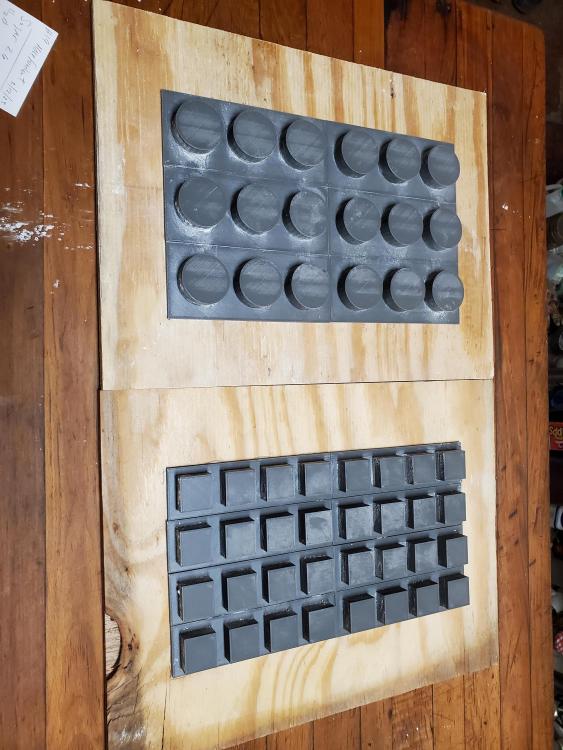
Capouch
participating member-
Posts
10 -
Joined
-
Last visited
Recent Profile Visitors
The recent visitors block is disabled and is not being shown to other users.
-
I have a Revolation X temperer and am anxious to try using cocoa butter silk for tempering. I've asked around but so far haven't found anyone who has done it. Called the manufacturer and they gave me a reference, but it didn't pan out: the fellow didn't respond to my inquiry. Has anyone here done it, and/or has any advice for me?
-
My starch-printing molds. I have two more finished that aren't mounted yet. The starch is in a 9x13 pan. Printing is a bit of a chore since I have found it essentially impossible to raise the mold straight up without slightly moving it to one side or the other, which often causes cave-ins or smears. I am working on a frame to hold the mold with an apparatus that will push it straight down into the starch, allow for more pressure that I can get just pushing with my hands, and most important, it will lift it straight back up. I also made a "pusher" for each shape that is the "negative" of one cavity with a handle on it. I use them to clean up any sloppy edges , sprinkles of starch in the bottom of a cavity, or slight cave-in.
-
- 1
-

-
The Comprehensive Home-Made Fondant Discussion: Making, Using, Storing
Capouch replied to a topic in Pastry & Baking
Essentially, yes. After that first response the UI didn't seem to allow me to answer the questions underneath each one. I basically use the Greweling recipe. Cook to 240, pour into a half-sheet pan that has been rinsed with cold water, then sprinkle with coild water. Agitate starting at 120, last two batches I have seeded with existing fondant; before that I did not. I agitate with a wooden spoon. Fondant is tested before each time I melt, smooth as can be, always. I even had some leftover from last spring when I started working a couple of months ago. It was weepy, but still perfectly smooth. I don't think it's my fondant; I think it's my technique somewhere. And since the finished but unmelted fondant is essentially perfect, as well as a high majority of the molded batches, I haven't had the motivation to change it up. All the crystals are going to melt when I melt it with the butter and flavorings, right? I haven't ever made it without butter, but as I said in the OP, 75%+ of what I make is fine, so if the butter were doing it I would think I'd see it more often. It seems random. . . . I usually drop the centers and then cover the next day. Always taste one from each batch, so I noticed it immediately on this most recent grainy batch. Three batches in a row ahead of this one were perfect, not same flavoring, but same butter and overall technique. -
The Comprehensive Home-Made Fondant Discussion: Making, Using, Storing
Capouch replied to a topic in Pastry & Baking
@minas6907 I've been making ~3-pound batches of fondant. I then melt the fondant in batches of about .75 pound; that's the quantity for one of my 9x13 starch trays. Just began using the invertase and not enough time has elapsed at present to know if it's working or not. Which is a sort of jiggled truth: I'd been using invertase for about 3 weeks, but then a few days ago realized that I had grabbed a year-old+ bottle that hadn't been refrigerated instead of the new one I got to replace it. Bad brain fart; I mixed up the bottles when the new one came in. -
The Comprehensive Home-Made Fondant Discussion: Making, Using, Storing
Capouch replied to a topic in Pastry & Baking
@minas6907 Maybe I didn't make the post clear enough: The fondant is FINE after I make it; it is smooth as silk and perfect as I understand what fondant is supposed to be. The problem is when I melt it and add butter and flavorings to make centers for bon-bons. It's fine, nice and smooth, about 75% of the time. The remaining times it has a very tongue-feelable graininess. Following advice I saw in a video I was heating to 140, but Greweling's advice is hotter, 160, so I started taking it up that high. Two batches done that way were fine, but the most recent batch--a 160 batch--was back to having that grainy feel. And that's the twist: the fondant is FINE until I melt and mix, and it doesn't always set grainy. But I don't know what parameter is causing it to do that. -
The Comprehensive Home-Made Fondant Discussion: Making, Using, Storing
Capouch replied to a topic in Pastry & Baking
I have a whole setup that uses 9x13 cake pans as the standard "starch pan." Molds for bon-bons, mint patties, 1/2 x 1" rectangles and a "pyramid" mold for jellied candies. I design my molds with an online CAD program, then 3d print them. I got 100# of molding starch from Staleys. The question would be the same whether starch-printed or cast into molds: what am I doing when I heat my fondant/butter/flavorings that is causing *some* of the batches to be grainy? I have an album of some of my current season's work. Note that I don't have a good way to store what I'm making, and the pieces get bumped and otherwise misfigured from their being stored in bulk in plastic bags. I make my own fondant and all fillings from scratch. I grew the strawberries for my strawberry candy, and I dry-roast peanuts and grind them in an Old Tyme mill for my peanut butter cups and peanut butter fudge. I do candy during the "stay inside" months and garden the rest of the year. I love what I'm doing and constantly strive to get better at it. https://photos.app.goo.gl/VofpCioJMMnpYwsb8 -
Inspired by the awesome videos coming out of the Hercules Candy shop in Syracuse, I have connived a system to starch "print" molds for my chocolate centers. I make my own fondant, and to make the "cream" centers I melt some of it with a bit of butter and other flavorings, and then drop it into my molds. It has been fun and people love the candy I'm making. However, I'm bedeviled by two issues, one of which I am desperate to solve. Even though the fondant is perfectly smooth on the tongue ahead of heating it, some of my batches turn out with the centers grainy. My protocol was originally to heat the center mixture to 140-145 F and then cast, after a discussion of temperatures on one of the Hercules videos. Greweling says to heat to 160, so I began warming it up a bit more. I also add a few drops of invertase to the mix. The first few batches I made that way were fine, and I assumed the graininess was due to the lower strike temperature I followed earlier. Not. My most recent batch turned out grainy. Will be overjoyed to consider any analysis/fixes that might be out there.
-
I purchased this mold recently on eBay, and have been having a spirited discussion about it with the vendor. I am curious about the irregular edges on the piece, which look to me like the result of the application of a pair of metal snips to a larger mold. Does anyone recognize this mold, and can comment on whether or not this is, in fact, the way the mold would have looked when originally fabricated? Thank you in advance for any information you might be able to provide.
-
I recently purchased a vintage metal chocolate mold. I was fascinated by its pattern, and it was relatively cheap. Now I'm trying to figure out how to use it. I have begun to suspect that it may have been designed for making some particular type of chocolate, and before I start acting on my various speculations, wanted to put a couple of images of it before this group to see if anyone might recognize what it was made for, or, alternatively, what I could use it to make. It's very heavy, and the cavities are in pretty good condition.
-
An introduction from a brand-new member. I am a retired college professor who in 2018 bought the empty shell of a gentleman farmer's mansion in northwestern, rural Indiana. The house, almost 6000 square feet, was designed by architect Fred Friedline, who practiced locally as well as in downtown Chicago. When purchased, the 1916 house had no working electrical, plumbing or heating systems, a badly leaking roof, and 30 broken windows. The homestead also has a 3-bay barn, chicken house, 3-seater brick outhouse, "cob house" for storing corncobs to power the kitchen stove, an "oil house" intended to separate volatile substances from the rest of the outbuildings, and the original mid-1860s house, which in 1916 was converted into a shop/garage, with a 2-room upstairs apartment. I have slowly made progress; the house is now habitable, has a new roof and working infrastructure. I have a small flock of chickens and a huge garden which has produced almost 3 tons of tomatoes in the past three seasons. I hope to make the place self-sustaining, and towards that end have been working on developing a number of food-related products that I hope to eventually make available in local markets. I have a semi-commercial kitchen with a South Bend 300-series range, 5'x3'x4" baker's table, and stainless sink-counter. I have a pair of La Parmigiana D45 pasta extruders with an array of dies, and have produced several hundred pounds of fresh bronze-cut pasta. I use an Old Tyme peanut butter mill to grind nut butters from nuts roasted in-house, and recently resuscitated an ACMC tabletop chocolate tempering machine, which I am using to learn the chocolatier's craft. I have found much useful information on this site, and will be posting shortly a couple of questions that I've encountered in my recent chocolate work. I've made about 600 dipped and molded chocolates so far in the last month, and have on hand about 50 pounds of Barry Callebaut coverture products, including formulas 811, 823, and W2. I've purchased several molds, plastic, polycarbonate and vintage metal, and have a large marble slab I'm using for hand dipping. I thank you for taking the time read, and hope I will be able to contribute a bit as well to the knowledge based on this site.
- 8 replies
-
- 11
-









